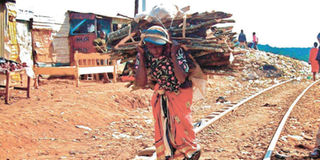Glimpses of Maisha in Kibera

A woman walks long the rail tracks in Kibera. Photo/JOHN FOX
The Kuona Trust Arts Centre is tucked away these days, but it is well worth finding. The centre is a not-for-profit organisation founded back in 1995, with a mission “to serve local artists” by providing studio space, mounting exhibitions and offering training opportunities.
Kuona started its lively life at the National Museum, where it couldn’t be missed by the many visitors who passed through the Museum’s main gate. It is now in Likoni Close at Hurlingham. To get there is a zig-zag.
In the direction away from town down Argwings Kodhek Road, you take a left at Chaka Place down Chaka Road, cross Lenana Road into Nyangumi Road, turn right into Dennis Pritt Road and almost immediately left into Likoni Lane – and then left again into Likoni Close. The centre is towards the end of the short cul-de-sac.
I was there last week at the opening reception for Maisha in Kibera, an exhibition of 30 photographs taken by students from St Aloysius Gonzaga Secondary School in Kibera.
On display
The six students whose photographs were on display – Oscar Juma, Maxwell Omondi Onyango, Miheso Esnas Ounda, Dickens Mwang’athia, Nancy Akinyi and George Obare – are all members of the school’s Journalism Club.
Now, I have some reservation about the kinds of interest we often see these days in life in the slums. It can become a rather unhealthy kind of voyeurism. But I have no such reservation about this exhibition. It is a view of the inside – from youngsters on the inside.
There is one photograph that immediately took my attention. It was of a woman with a heavy load of wood across her shoulders, walking along the railway line that runs through the slum.
It took me back to my first visit to Kenya in the late 1960s. I remember how the women used to walk with loads like this along the winding dirt tracks that skirted the main roads on the outskirts of the city – symbolic of the two worlds that co-existed in Nairobi.
I came to realise, too late, that I should have taken photographs of the things that took my attention in my first few days here – because, before long, such things became the ordinary and the unremarkable ...
So I put this thought to the young Oscar Juma.
“Oh, it’s different for me,” he said. “I am from Kibera, you see – and I want to tell the ordinary story of Kibera to people out there.”
He is a remarkable young man, Oscar Juma ... Well, he might well be not so remarkable in the eyes of those who work and teach at the St Aloysius Gonzaga Secondary School, and who have become accustomed to recognising talent in the youngsters of Kibera – in youngsters who, but for the school, might never have had the chance to develop and express that talent.
“Being born in Kibera doesn’t mean that you are incapable,” Oscar said. “Nor is it an excuse to sit back and do nothing.”
Muddy stream
And these six students have done something quite special. Among their 30 photographs, there are some that are broad shots of Kibera – a little boy, for example, standing beside a muddy stream, with the shanties piled up the banks.
Some are poignant: like of the little girl watching her older brother tend a tiny cabbage patch – or the teenager trying to study in a cramped room and with a dim light.
Others are artistic – like the shot of a wet pair of shoes left out to dry on a corrugated iron roof ...
Unfortunately, the exhibition was for only one week, and it ended August 6. There is a surprising quality in these photographs – and they deserve to be shown more widely.
If you want to find out whether and where they will be exhibited again, you can contact Sean Fitzpatrick on 0712 573 620.
John Fox is Managing Director of IntermediaNCG
Email: [email protected]




